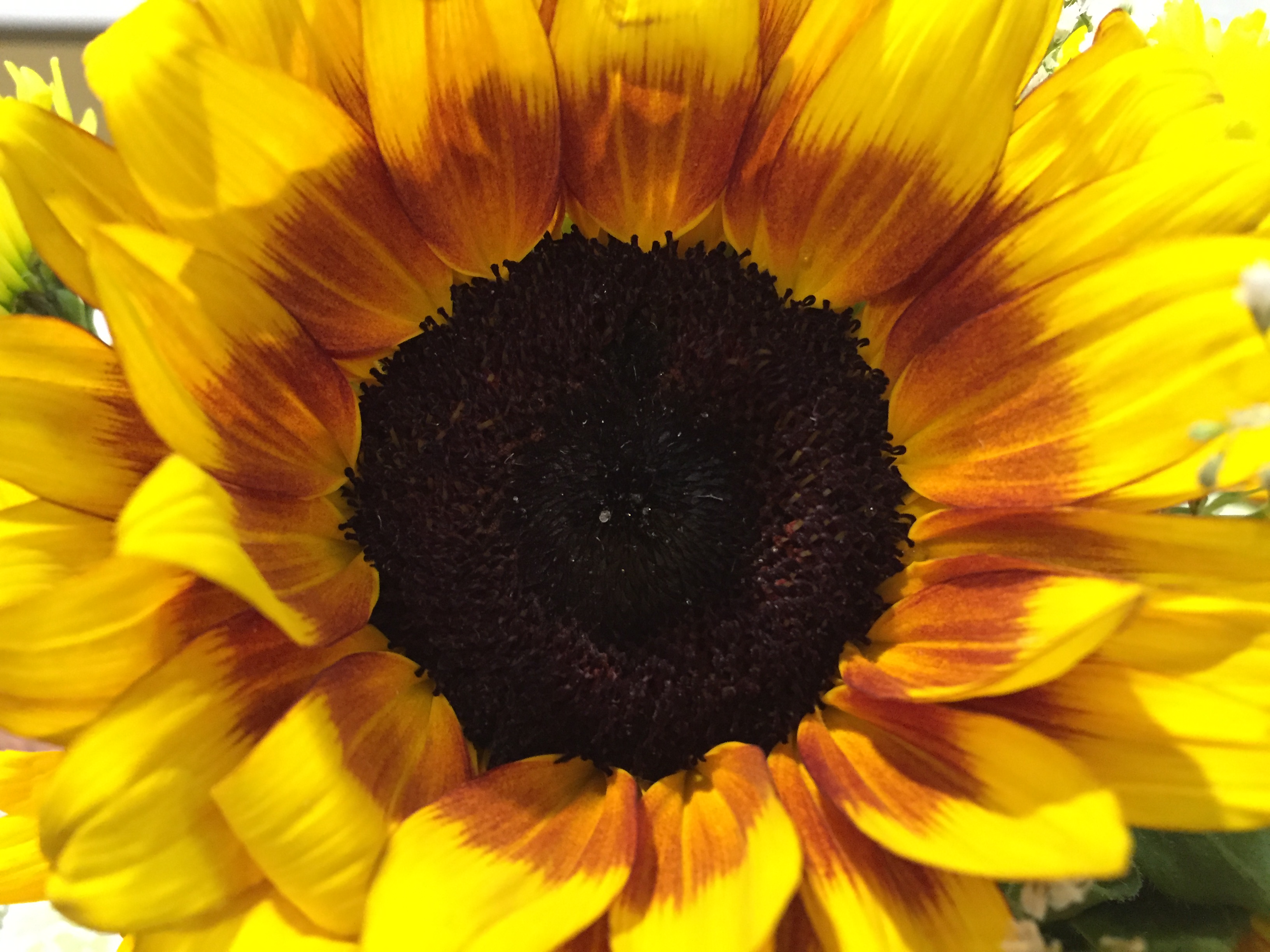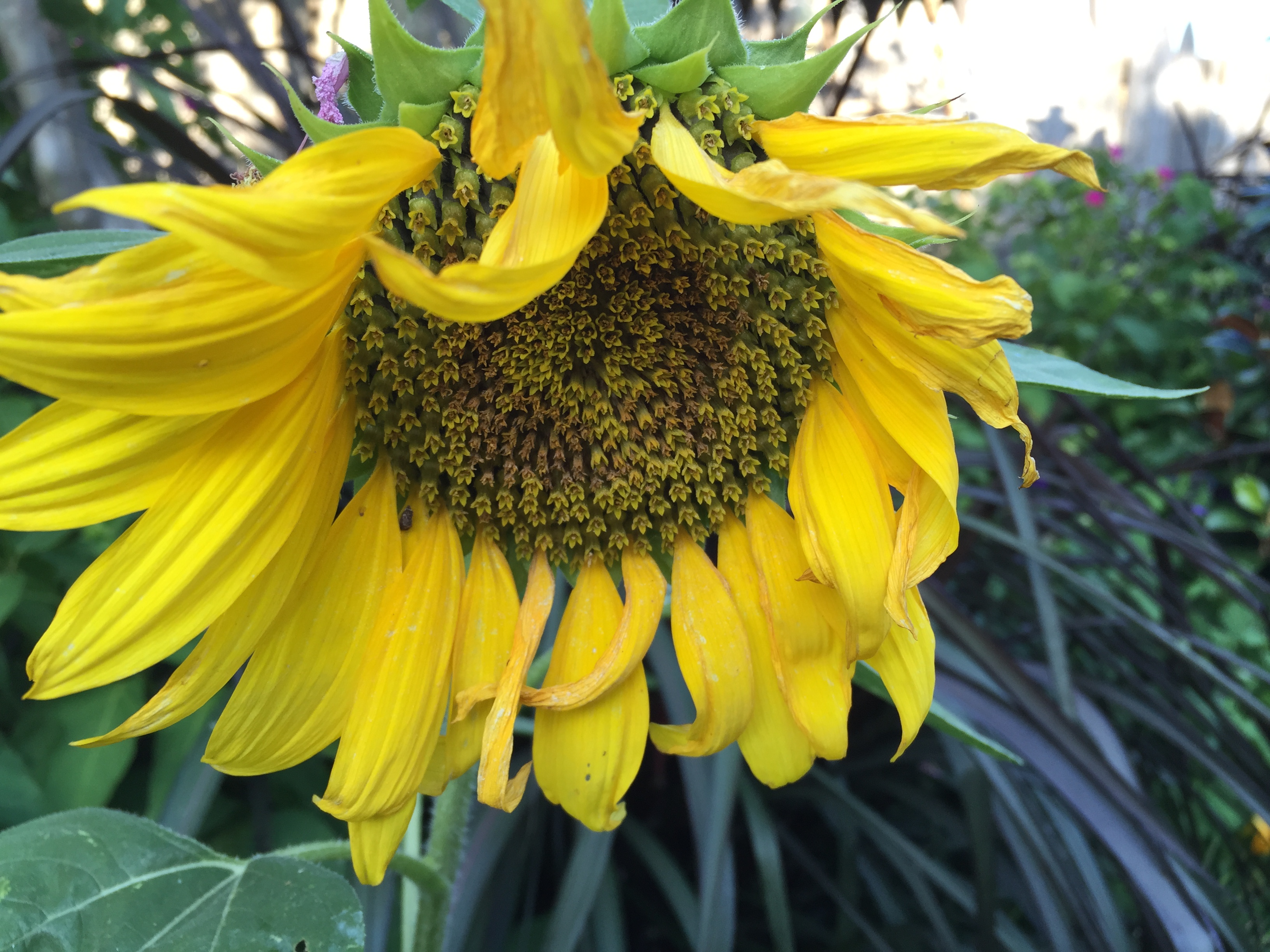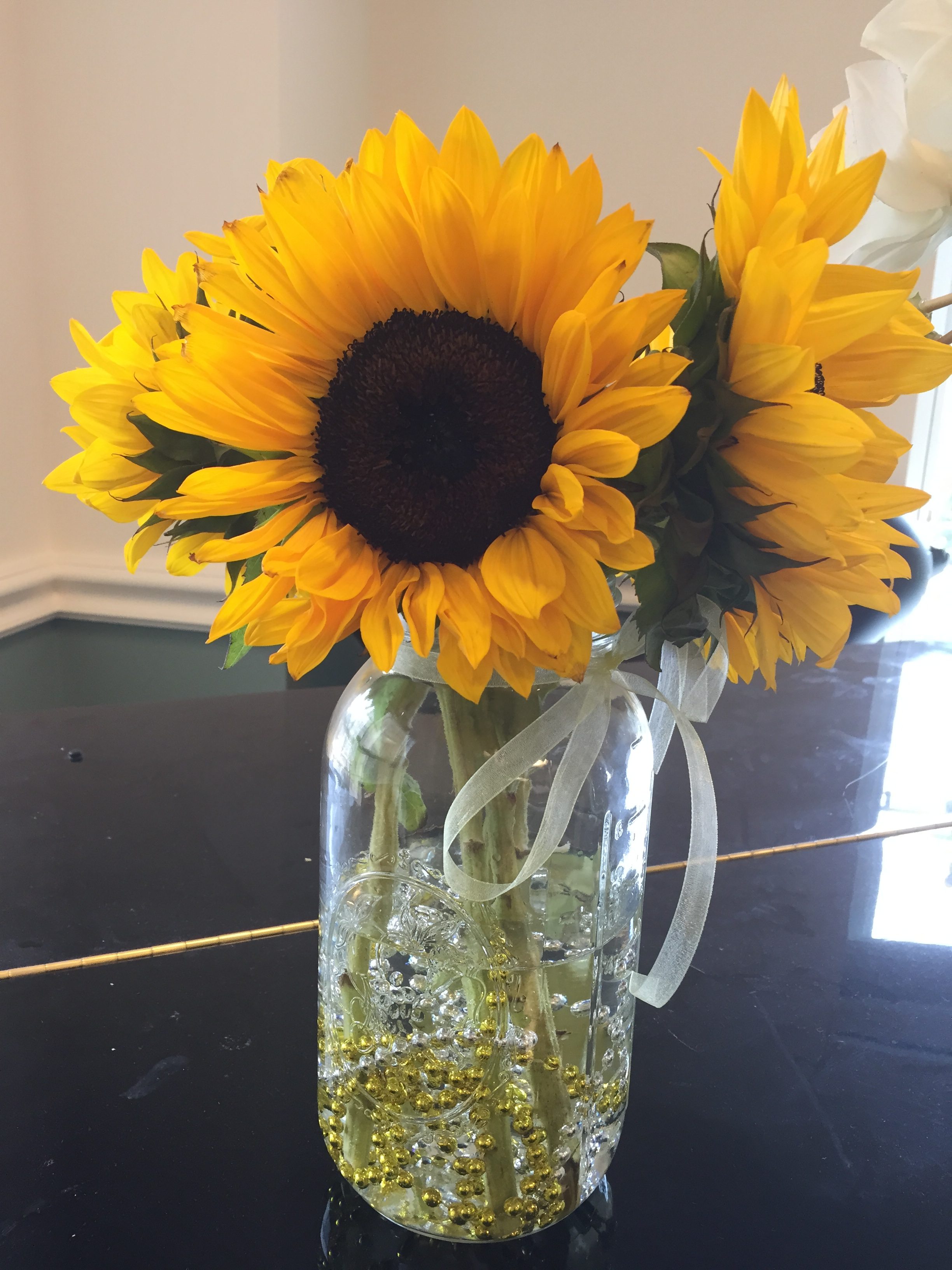Sunflowers. Beautiful, cheerful sunflowers. Flowers that resemble the sun with their rays of golden yellow petals. Aside from roses, sunflowers are perhaps the most recognizable and friendliest of flowers.
At the sight of sunflowers, people are often transported in their minds to driving past fields of sunflowers in the Midwest or seeing the mammoth sunflowers that grandma grew in the backyard – you know, the ones that towered over you as a child. Or, there is a memory of picking the ripe sunflower seeds of the spent flower. I can also remember watching birds swarming around ripe sunflowers – perched on the fence, tree branches, wherever and taking turns flying to the flowers, pecking off some seeds, landing on the ground to eat them, and then back again, with the occasional altercation or squirrel.
Here are some interesting facts about sunflowers.
 Sunflowers are Helianthus annuus, from the Greek words ‘helios’ for ‘the sun’ and ‘anthos’ for ‘flower.’ ‘Annuus’ for ‘annual’ references the flower’s complete life cycle in one growing season.
Sunflowers are Helianthus annuus, from the Greek words ‘helios’ for ‘the sun’ and ‘anthos’ for ‘flower.’ ‘Annuus’ for ‘annual’ references the flower’s complete life cycle in one growing season.
Sunflowers are native to North America. Though several of my favorite plants are native to other parts of the world, sunflowers are native to this continent. Native Americans traditionally used sunflowers for culinary, medicinal, and dye-making purposes.
 Sunflowers come in a variety of colors and sizes. The “traditional” sunflower has mustard yellow petals surrounding a dark center, atop a tall sturdy stem. There are a multitude of different flower heights and colors. ‘Mammoth Russian’ sunflowers are as big as the name suggests and grow up to approximately 15 feet tall (Renee’s Garden). (Check out more tall sunflower varieties.) There are dwarf types, including ‘Elves Blend’ which grows 16 inches to 2 feet tall (Botanical Interests) – and then everything in between. There are also sunflowers with the creamy yellow – almost white petals of ‘Vanilla Ice’ (Burpee), burgundy petals of ‘Chocolate’ (Johnny’s Selected Seed), and the bicolor flowers like ‘Strawberry Blonde’ (Johnny’s Selected Seed) or ode-to-Johnny-Cash ‘Ring of Fire’ (Seed Savers Exchange). Check out the unusual, “shaggy blooms” of ‘Teddy Bear’ (Johnny’s Selected Seed) or the beautiful blend of fall colors of ‘Autumn Beauty’ (Seed Savers Exchange). New in 2016 – ‘Sundancer’ grows quickly to 4-6 feet tall and blooms early in the season (Renee’s Garden).
Sunflowers come in a variety of colors and sizes. The “traditional” sunflower has mustard yellow petals surrounding a dark center, atop a tall sturdy stem. There are a multitude of different flower heights and colors. ‘Mammoth Russian’ sunflowers are as big as the name suggests and grow up to approximately 15 feet tall (Renee’s Garden). (Check out more tall sunflower varieties.) There are dwarf types, including ‘Elves Blend’ which grows 16 inches to 2 feet tall (Botanical Interests) – and then everything in between. There are also sunflowers with the creamy yellow – almost white petals of ‘Vanilla Ice’ (Burpee), burgundy petals of ‘Chocolate’ (Johnny’s Selected Seed), and the bicolor flowers like ‘Strawberry Blonde’ (Johnny’s Selected Seed) or ode-to-Johnny-Cash ‘Ring of Fire’ (Seed Savers Exchange). Check out the unusual, “shaggy blooms” of ‘Teddy Bear’ (Johnny’s Selected Seed) or the beautiful blend of fall colors of ‘Autumn Beauty’ (Seed Savers Exchange). New in 2016 – ‘Sundancer’ grows quickly to 4-6 feet tall and blooms early in the season (Renee’s Garden).
The tallest sunflower measured at 30 feet 1 inch tall. The Guinness World Record holder was grown by Hans-Peter Schiffler in Germany in 2014. That’s about 2.5 stories tall! (Check out a video of the tallest sunflower.)
Sunflowers are hyperaccumulators – or “soil cleaners.” Sunflowers aren’t just pretty faces. They are used in phytoremediation to help rehabilitate soils and groundwater that contain heavy metals, such as lead, uranium, and cesium. In fact, sunflowers were planted near Chernobyl and Fukushima to remove the toxins after the nuclear plant disasters.
Young sunflowers track the sun’s movements in a process called heliotropism. Perhaps one of the most interesting things about sunflowers is the young plants’ ability to follow the sun as it moves in the sky throughout the day. A young plant starts its day greeting the sun as it rises in the east. Then the tip growth moves during the day, “following” the angle of the sun before ending its day facing west at sunset. During the night, it resets itself to once again face east by sunrise in the morning. Eventually as growth develops and flower buds form, the stem hardens and becomes rigid, not allowing for further movement. The sunflower ends up facing east, generally speaking, and no longer tracks the movement of the sun. Read more about these flowers’ circadian rhythm and why the it tracks the sun. watch time lapse video of a sunflower seedling tracking the sun.
 Have you ever noticed the Fibonacci patterns on the sunflower? Look closely at the center of a sunflower, and you’ll notice a spiral pattern. You may have also noticed this pattern on agave, cactus thorns, snail shells, the Milky Way, hurricane formations, the bottom of a pine cone, and more. The sunflower florets are arranged in a unique mathematical pattern as to create a series of interconnected spirals. Read more about what causes this.
Have you ever noticed the Fibonacci patterns on the sunflower? Look closely at the center of a sunflower, and you’ll notice a spiral pattern. You may have also noticed this pattern on agave, cactus thorns, snail shells, the Milky Way, hurricane formations, the bottom of a pine cone, and more. The sunflower florets are arranged in a unique mathematical pattern as to create a series of interconnected spirals. Read more about what causes this.
- Watch time lapse video of a sunflower seedling tracking the sun.
- Sow sunflower seeds, either by direct sow in the garden or in pots to transplant later in the garden. Try growing the giant sunflowers in your garden – research how to grow the biggest, tallest varieties in your garden.

- Create sunflower arrangements using flowers cut from the garden or purchased from the florist.
- Examine a sunflower up close. Notice the rigidness and height of the stems, the texture of the leaves and stems, the soft fuzziness of the point where the back of the flower meets the stem, the Fibonacci patterns of the flower’s “eye,” the colorful petals, the sticky part of the flower’s “eye” (at least on cut flowers, that is)…what else? This can be quite a grounding sensory experience.
- Notice the Fibonacci patterns of the sunflower florets and study other plants and objects in nature that also contain this pattern. Learn more about the Golden Ratio – this could possibly be a bridge, or lead into a conversation, about the Golden Rule: Treat others as you would like to be treated.

- Examine pictures of Monet’s sunflower paintings or Van Gogh’s series of sunflower paintings painted in anticipation of a visit from his buddy Paul Gauguin. Think about how nature has inspired the masters’ work, particularly Van Gogh who painted sunflowers in all stages – from young flowers to those past their prime. Create your own floral arrangement featuring sunflowers and then have the group sit in a circle around the arrangement. Then encourage them to paint or sketch a still life from their perspective. Paintings and sketches will most likely be different from all angles and can be a good topic about perspective in a group discussion.
- Harvest sunflower seed once ripened. Pick the sunflower seeds out of the flower head by hand – this challenges fine motor skills.
- Scatter sunflower seed, with other birdseed, outside for the birds. Or, fashion birdseed “cookies” with seed, flour, water, and corn syrup. Hang outdoors using a piece of twine as a hanging bird feeder. (Birdseed ornament recipe here.)



What a fantastic collection of all things related to sunflowers! Thank you!
In a craft store yesterday I came across a silk sunflower with the bottom end of a pinecone used as the center of the flower. What a great way to re-create the center for a craft since it too reflects the Fibonacci sequence.